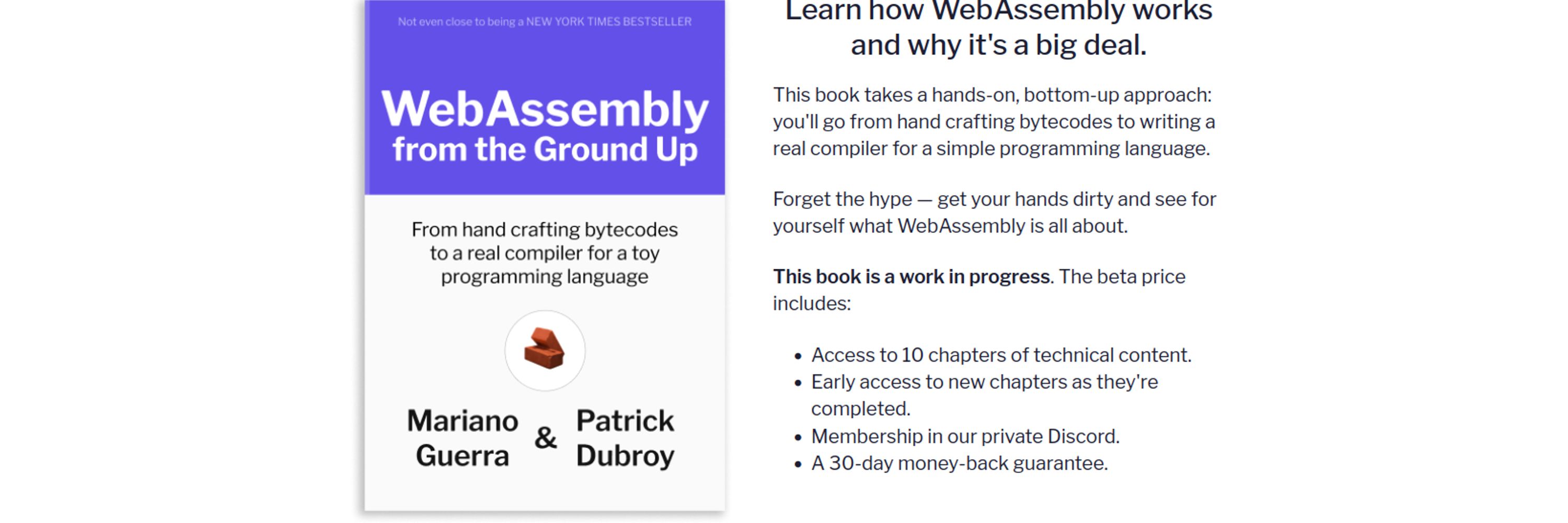
https://wasmgroundup.com/

It's the book we wish we'd had 3 years ago.
No messing with tools and frameworks. It's a hands-on guide to the core of Wasm: the instruction set and module format.
Link below. 👇
That's why, in the library we create for producing Wasm modules, we aim for "eye-closeness" with the spec.
Left: code from the book.
Right: the 1.0 spec text.
![// im*:vec(import)
export function importsec(ims) {
return section(SECTION_ID_IMPORT, vec(ims));
}
// mod:name nm:name d:importdesc
export function import_(mod, nm, d) {
return [name(mod), name(nm), d];
}
export const importdesc = {
// x:typeidx
func(x) {
return [0x00, typeidx(x)];
},
};](https://cdn.bsky.app/img/feed_thumbnail/plain/did:plc:zmdqpvhi7mrerefow5jxqcb6/bafkreig3vx6db3x3iuay3mlquwpobn7hgig2nsyvqny25g6lxzyyy4pbky@jpeg)

That's why, in the library we create for producing Wasm modules, we aim for "eye-closeness" with the spec.
Left: code from the book.
Right: the 1.0 spec text.
If you've read the book and enjoyed it, and feel like leaving a comment, it would certainly help us out!

If you've read the book and enjoyed it, and feel like leaving a comment, it would certainly help us out!
→ kennyfully881230.github.io/wasm_fun/was...
"I ended up learning a lot about how to use linear memory to render one time to the canvas on every frame. Not only that, I learn how to do collisions, sprite clipping etc all in Wasm."
Source code: github.com/kennyfully88...
→ kennyfully881230.github.io/wasm_fun/was...
"I ended up learning a lot about how to use linear memory to render one time to the canvas on every frame. Not only that, I learn how to do collisions, sprite clipping etc all in Wasm."
Source code: github.com/kennyfully88...
A WebAssembly interpreter (Part 1)
→ wasmgroundup.com/blog/wasm-vm...
We build up a simple interpreter from scratch, in JavaScript, for a small subset of Wasm instructions (arithmetic and comparison).

A WebAssembly interpreter (Part 1)
→ wasmgroundup.com/blog/wasm-vm...
We build up a simple interpreter from scratch, in JavaScript, for a small subset of Wasm instructions (arithmetic and comparison).
"My First Fifteen Compilers" by Lindsey Kuper
blog.sigplan.org/2019/07/09/m...

Authors Patrick @dubroy.com and @marianoguerra.org think it's crucial for learning. They join #WasmAssembly host Thomas Steiner to discuss their ebook, "WebAssembly from the Ground Up" → goo.gle/3Ln67Pp

Authors Patrick @dubroy.com and @marianoguerra.org think it's crucial for learning. They join #WasmAssembly host Thomas Steiner to discuss their ebook, "WebAssembly from the Ground Up" → goo.gle/3Ln67Pp
github.com/WebAssembly/...
Also immortalized in song: suno.com/song/19e0679...

github.com/WebAssembly/...
Also immortalized in song: suno.com/song/19e0679...

We (@dubroy.com and @marianoguerra.org) are planning to be there. Patrick tomorrow, and both of us on Thursday for the Research Day.
If you see us, come say hi!
We (@dubroy.com and @marianoguerra.org) are planning to be there. Patrick tomorrow, and both of us on Thursday for the Research Day.
If you see us, come say hi!
#WebAssembly from the Ground Up with @dubroy.com and @marianoguerra.org. Learn how they're teaching #Wasm by building a compiler in JavaScript and why writing Wasm by hand is crucial!
🍿 www.youtube.com/watch?v=dRdD...
🎧 wasmassembly.libsyn.com/webassembly-...

#WebAssembly from the Ground Up with @dubroy.com and @marianoguerra.org. Learn how they're teaching #Wasm by building a compiler in JavaScript and why writing Wasm by hand is crucial!
🍿 www.youtube.com/watch?v=dRdD...
🎧 wasmassembly.libsyn.com/webassembly-...
→ users.cs.northwestern.edu/~robby/pubs/...
Benchmarks Wasm implementations of Dart, Haskell, Scheme, OCaml, Ruby against the native impls.

→ users.cs.northwestern.edu/~robby/pubs/...
Benchmarks Wasm implementations of Dart, Haskell, Scheme, OCaml, Ruby against the native impls.
→https://github.com/pdubroy/til/blob/main/js/2025-10-05-WebAssembly-library-initialization-patterns.md


Figma rendering: Powered by WebGPU
→ www.figma.com/blog/figma-r...
Also talks a bit about their overall app architecture, and how they use #wasm.

Figma rendering: Powered by WebGPU
→ www.figma.com/blog/figma-r...
Also talks a bit about their overall app architecture, and how they use #wasm.
webassembly.org/news/2025-09...
This includes major features like GC, 64-bit memories, exceptions, and tail calls.

webassembly.org/news/2025-09...
This includes major features like GC, 64-bit memories, exceptions, and tail calls.
This is cool!
Wasm brings all the VMs to tiers!
This is cool!
Wasm brings all the VMs to tiers!
AnyBlox: A Framework for Self-Decoding Datasets
→ gienieczko.com/anyblox-paper
/ht Jamie Brandon (www.scattered-thoughts.net/log/0054/)

AnyBlox: A Framework for Self-Decoding Datasets
→ gienieczko.com/anyblox-paper
/ht Jamie Brandon (www.scattered-thoughts.net/log/0054/)
Some good examples here of what makes language design so tricky.
"I'll go through the six features of Markdown that I think have created the most difficulties"
Beyond Markdown: johnmacfarlane.net/beyond-markd...
Some good examples here of what makes language design so tricky.
Which means: it's not too late to snag a copy of the book in our summer sale!
So, it's time for a ☀️ SUMMER SALE ☀️ —
Use the code SUMMER25 for a 25% discount on the book until Sept 15: wasmgroundup.com

Which means: it's not too late to snag a copy of the book in our summer sale!
It’s really well written and focuses on how WebAssembly is written by teaching you to write a compiler for it. Which is honestly pretty genius.

It’s really well written and focuses on how WebAssembly is written by teaching you to write a compiler for it. Which is honestly pretty genius.
So, it's time for a ☀️ SUMMER SALE ☀️ —
Use the code SUMMER25 for a 25% discount on the book until Sept 15: wasmgroundup.com

So, it's time for a ☀️ SUMMER SALE ☀️ —
Use the code SUMMER25 for a 25% discount on the book until Sept 15: wasmgroundup.com
It's built on the low-level assembler lib we created for @wasmgroundup.com, but has some nice higher-level features, including labeled breaks. I'm particularly proud of the idea to put the block label at the end. 😊

It's built on the low-level assembler lib we created for @wasmgroundup.com, but has some nice higher-level features, including labeled breaks. I'm particularly proud of the idea to put the block label at the end. 😊
→ labs.leaningtech.com/blog/branch...
An interesting look at journey from an idea ("it should would be nice if Wasm supported this…") to a standardized feature.

→ labs.leaningtech.com/blog/branch...
An interesting look at journey from an idea ("it should would be nice if Wasm supported this…") to a standardized feature.
Since 2017, my work on Ohm has been unpaid. Your sponsorship helps the project be sustainable, ensuring that I can maintain and improve Ohm for many years to come!
Since 2017, my work on Ohm has been unpaid. Your sponsorship helps the project be sustainable, ensuring that I can maintain and improve Ohm for many years to come!


